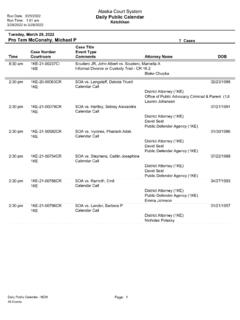Transcription of INSTRUCTIONAL DESIGN IN EDUCATION: NEW MODEL
1 TOJET: The Turkish Online Journal of Educational Technology January 2011, volume 10 Issue 1 Copyright The Turkish Online Journal of Educational Technology 136 INSTRUCTIONAL DESIGN IN EDUCATION: NEW MODEL Prof. Dr. Aytekin MAN Sakarya University, Turkey & INTRODUCTION Instruction is a plan of teaching & learning activities in which learning is organized. This INSTRUCTIONAL plan motivates students to learn. The aim of instruction is to make the learning process take place. According to Gustafson (1996), INSTRUCTIONAL DESIGN is: 1. analyzing what is to be taught/learned; 2. determining how it is to be taught/learned; 3. conducting tryout and revision; and 4. assessing whether learners do learn. Instruction is a systematic process in which every component ( teachers, students, materials, and learning environment) is crucial to successfully learning (Dick & Carey, 1996).
2 Instruction deals with teaching and learning activities. These activities should assist students to learn knowledge and move this knowledge from short term memory to long term memory. To do that, students need to learn how to rehearse, encode, process and feedback new knowledge to be able to remember when they need. In the INSTRUCTIONAL DESIGN process, there are a lot of factors that should be taken into consideration. These factors are closely related to each other and affect each other to a certain extent. These factors should be organized in the INSTRUCTIONAL DESIGN steps. For example, if the goals and objectives are not chosen, specified or written properly, then the next and other steps will contain some problems because of the inappropriate and incomplete items in the previous step.
3 In the INSTRUCTIONAL DESIGN , the steps are all interrelated with each other. It is very important to order the steps in a way that will be logical and in relation with other steps. In other words, INSTRUCTIONAL DESIGN is a big responsibility to DESIGN teaching and learning activities. All steps should be thought and chosen carefully and should be ordered in a meaningful way. Every detail can play an important role during the implementation. Every decision should be given due to a reason, not just for the sake of doing so. The designer should be fully aware of the relationship among the steps. During the teaching and learning process, the designer should collect reliable data about the students, their backgrounds and their prerequisite learning. Due to the reason that they play an important role on the outcomes of instruction, they should seriously taken into consideration and help designer to create a MODEL that will help them to keep a balance between them.
4 An INSTRUCTIONAL DESIGN MODEL gives method and implication to DESIGN instruction. During the INSTRUCTIONAL DESIGN process, models help educators to visualize the problem. If the INSTRUCTIONAL DESIGN MODEL solves the learning-teaching problems, it means that it is an effective instruction. Effective instruction is instruction that enables students to acquire specified skills, knowledge, and attitudes (Reiser & Dick, 1996). During the effective instruction, students can be motivated well. To motivate students in the instruction process, all factors must be determined well. During determination process, there are four important principles that play key role. These principles are listed below: 1. Begin the planning process by clearly identifying the general goals and specific objectives students will be expected to attain; 2.
5 Plan INSTRUCTIONAL activities that are intended to help students attain those objectives; 3. Develop assessment instruments that measure attainment of those objectives; 4. Revise instruction in light of student performance on each objective and student attitudes towards INSTRUCTIONAL activities (Reiser & Dick, 1996). Teachers should follow these principles in order to apply successfully their instruction. The major goal of INSTRUCTIONAL DESIGN is to demonstrate planning, developing, evaluating, and managing the INSTRUCTIONAL process. At the end of this process, it can be seen the student learning performance in INSTRUCTIONAL activities based upon defined goals and objectives. INSTRUCTIONAL DESIGN pays attention to instruction from the learner perspective than from the content perspective which is traditional approach.
6 According to Kemp, Morrison and Ross (1994), it involves many factors that influence learning outcomes, including such questions as these: 1. What level of readiness do individual students have for accomplishing the objectives? TOJET: The Turkish Online Journal of Educational Technology January 2011, volume 10 Issue 1 Copyright The Turkish Online Journal of Educational Technology 1372. What teaching and learning methods are most appropriate in terms of objectives and student characteristics? 3. What media or other resources are most suitable? 4. What support, beyond the teacher and the available resources, is needed for successful learning? 5. How is achievement of objectives determined? 6. What revisions are necessary if a tryout of the program does not match expectations? These questions concerns with student learning because the major goal of INSTRUCTIONAL DESIGN is to accomplish the identified goals and objectives in the INSTRUCTIONAL activities.
7 In the INSTRUCTIONAL DESIGN process, there are four key elements. These are: 1. whom to teach, 2. what to teach, 3. how to teach, and 4. how to evaluate. In whom to teach process, knowing student personality is important because the target learners are students. Without students, INSTRUCTIONAL activities can t be implemented. To DESIGN effective instruction, teachers should get information about student characteristics. In what to teach, INSTRUCTIONAL goals and objectives are important. Teachers first must make decision on their goals and objectives in INSTRUCTIONAL DESIGN . INSTRUCTIONAL goals and objectives give teacher information on what to teach during INSTRUCTIONAL activities. In how to teach, teacher gets information on how to deliver goals and objectives to students in the instruction.
8 INSTRUCTIONAL delivery methods indicate teacher what kinds of teaching and learning methods will be used. In how to evaluate, assessment tools are playing key role because teacher can get information on whether students accomplished the goals and objectives or not with the tools. During the educational measurement and evaluation process, assessing tools such as multiple choice, short-answer items, true-false items, matching items, essay questions, problem solving questions and others must be used to determine student learning activities in the instruction by teacher. These assessing tools should have reliability and validity characteristics to determine learning outcomes. These four elements are usually used to create an INSTRUCTIONAL DESIGN MODEL .
9 There are four kinds of INSTRUCTIONAL models (Gustafson, 1996). These are classroom MODEL , product MODEL , INSTRUCTIONAL systems models, and trends and issues. The classroom models such as Gerlack & Ely, Kemp, Heinich, and Reiser &Dick are designed teacher oriented based. Teachers can use this MODEL to DESIGN instruction. The product models such as Bergman & Moore and Van Patten are interested in more producing INSTRUCTIONAL products either for specific clients or for commercial marketing. INSTRUCTIONAL system MODEL such as branson , Seels & Glasgow, Bridggs, Gagne, Smith &Ragan, Gentry and Dick Carey are designed for a complete college course. This MODEL always requires a team effort to DESIGN instruction. There are some trends and issues in INSTRUCTIONAL DESIGN models.
10 Hypermedia or internet is one of them. It affects INSTRUCTIONAL DESIGN . It is another area generating considerable excitement and innovation in the DESIGN of education and training environments (Gustafson, 1996). The other one is constructivism. It has also affected instruction process. It has gained considerable attention from educators dissatisfied with behaviorism and cognitive psychology. It is based on the belief that all individuals construct their own reality (Gustafson, 1996). NEW INSTRUCTIONAL DESIGN MODEL The major goal of new MODEL (Figure 1) is to point up how to plan, develop, implement, evaluate, and organize full learning activities effectively so that it will ensure competent performance by students. The theoretical foundation of new MODEL comes from behaviorism, cognitivism and constructivism views.
















